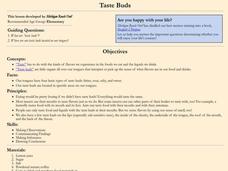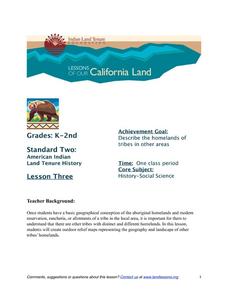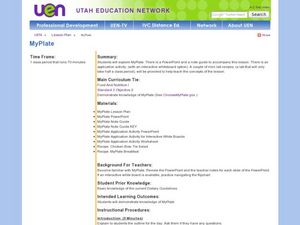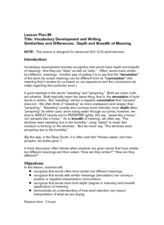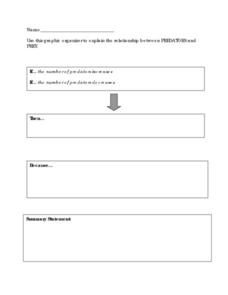Curated OER
Taste Buds
Students investigate taste buds. In this taste buds lesson, students identify the four basic taste buds and their locations on our tongue. Students participate in an experiment to investigate how our taste buds work.
Curated OER
Matching Meals Nutrition
Pupils play a matching game to practice pairing foods with their food groups. In this health and nutrition lesson, the class discusses food choices, then students play an on-line memory game.
Curated OER
What Food Is It?
Students close their eyes and taste foods without using the sense of sight to identify the foods. They record what they think the food is that they tasted.
Science Matters
Oh Heron
Two teams—the environmentalists and herons—play four rounds of the game, Oh Heron. Using hand symbols to represent food, shelter, and water, players locate their match to produce more herons while those unmatched decompose.
Curated OER
The Living Environment
In this living environment worksheet, students complete a crossword puzzle given 34 clues about the various species in the environment that produce, consume and decompose. Topics also include photosynthesis, respiration, glucose, organic...
Curated OER
Basic Vitamins: Water-Soluble and Fat-Soluble
Students examine vitamins and study their functions and food sources. They research what happens to vitamins when foods are overcooked. They prepare a microwaveable vegetable quiche.
Curated OER
Science Unit Lesson Five
Sixth graders review how and which plants operate in terrariums. In groups, they follow instructions to make their own terrarium and place different types of plants in it. To end the activity, they review the steps in the water cycle and...
National Wildlife Federation
What's Your Habitat?
How are third graders like rabbits? They both live in habitats and require food, water, and shelter to survive! An educational science lesson encourages your learners to think about their own habitats and survival needs, before comparing...
NOAA
Through Robot Eyes
How do robots assist ocean explorers in collecting data and images? The final installment in a five-part series has science scholars examine underwater images collected by robots and identify the organisms shown. Groups then calculate...
Indian Land Tenure Foundation
More Tribal Homelands
Here is a very fun idea that introduces young learners to how geographical location affects cultural development. They are introduced to four areas where Native Americans have lived in the past by reading stories and examining images....
Curated OER
Primary PE Lesson
Young scholars divide into two groups facing each other; tossing the bean bags to each other. The teacher calls out names of unhealthy food and students start to throw beanbags back and forth to their partner. When young scholars hear a...
Curated OER
MyPlate
A nice, neat PowerPoint accompanies this lesson plan, explaining each of the MyPlate dietary recommendations. Another PowerPoint gives the class the opportunity to apply the concepts of MyPlate on a worksheet. Recipes are provided for...
Curated OER
Vocabulary Development and Writing
Engage pupils in practicing denotative and connotative strategies to understand particular words. They work in pairs and write a series of sentences using each word that has a positive connotation and negative connotation. Some example...
Curated OER
Good Enough To Eat
Students are introduced to the five food groups. In groups, they place different foods into the correct section of the Food Pyramid. Using different types of technology, they create one page of a class ABC book sharing what they know...
Curated OER
America, A Home for Every Culture
Students investigate the many cultures that are represented in America. In this American culture lesson, students look at the food, languages, music, and traditions that immigrants have contributed to the face of America. They complete...
Curated OER
Dietary Guidelines/Food Pyramid Test
Students list the recommended dietary guidelines and explain their function and implementation. They teat their knowledge of the Dietary Guidelines and the Food Guide Pyramid. They evaluate the servings, serving sizes, and food sources...
Curated OER
How do pollutants bioaccumulate and biomagnify?
Learners review the basic concepts of the food chain. In small groups, they research an organism and create a food web. In addition, they study biomagnifications and write a brief essay or make a poster informing others about the...
Curated OER
Predators and Prey
Students explain how the food chain works. They contrast predators with prey and describe their function in nature. Students discuss how the food chain aids in keeping nature balanced. In small groups, they play a game that simulates the...
Curated OER
Predator/Prey
Students explain how the food chain works. They contrast predators with prey and describe their function in nature. Students discuss how the food chain aids in keeping nature balanced. They play a game that simulates the food chain.
Curated OER
Survivor!
Students, in groups, create a project to display examples and non-examples of basic needs. They answer what is needed for basic survival of all living things.
Curated OER
Animal Homes
Students explore how an animal's relationship to its habitat affect the animal's survival. They discuss animal habitats and the animal's relationship to that habitat through the food chain, life cycle, community, and balance of nature....
Curated OER
Internet Scavenger Hunt
Students use a computer and the internet to click on highlighted words to find certain answers. They then write the answer to the questions on paper. Finally, students choose one animal to write about. They research the animal on the...
Curated OER
Basic Nutrition (Nutri/Food)
Students analyze the nutrition found in a food and compare it to the nutrition found in similar food. They compare the nutrition of different products and complete the student worksheet Pyramid Pizzazz. This can be done at the beginning...
Curated OER
Giant Fast Food - McTwisted
Students discover the basics of Trademark Law understanding that companies are very protective of their trademarks and trade dress. Companies should be contacted for permission to derive their products. After obtaining permission,...
